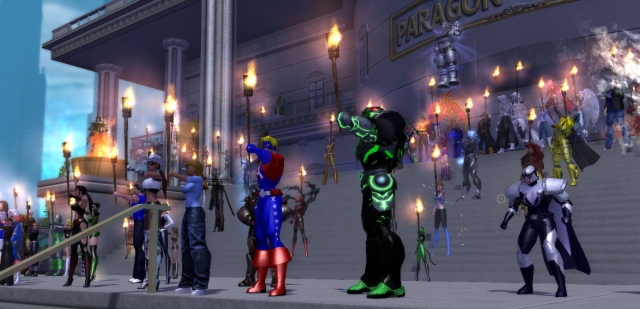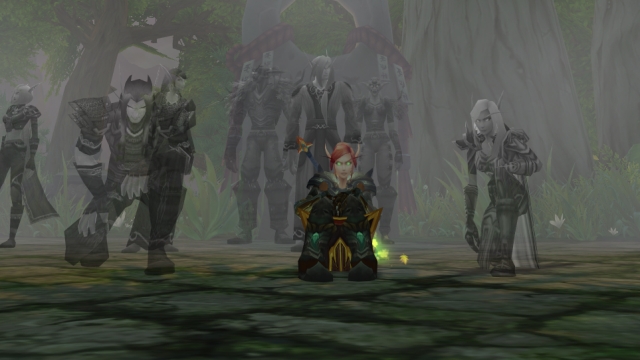No game lasts forever, including online ones. There’s always some push and pull to how many players are in a given game, and that new game is not going to have a huge player population. All of this is natural. However, understanding this doesn’t help much when you are trying to recruit new members to the guild and you look across a friend list that has actual tumbleweeds blowing across it, because there’s no one around any more.
Healthy games do, in fact, experience ebbs in the population. You should expect that. However, leading a guild in a game in the middle of an ebb poses unique challenges, and as a result, you have to be ready to deal with this problem. It’s something that’s going to affect the members, so if you’re not in charge of the guild, you still want to be aware of it.
For this article, I’m not going to be talking about why the game is ebbing–let’s take that as a given. There’s no need to go out and see whether or not the population is actually trending down at all; you know it’s happening. You know it’ll fill up again later, but how do you deal with it now?

Double down on the game itself
The first instinct I see in a lot of guild leadership–and I do mean a lot–is to make a real effort to keep the guild’s primary social space online. The idea is that if people are stepping away from the game for a bit, this reinforces the guild as a shared social space, right? Sure, you might not be feeling the game proper as much any more, but you’re still part of the gang, you’re still a team player. You’re still all together.
And that’s a great idea if you want to ensure that the guild is no longer actually a part of the game. Because that’s the message you’re sending.
I realize this might seem a little bit harsh, but if you want to keep playing this game, you want to also make it clear to people that this game is where the guild is. Not another game, not another venue, not a website or a Twitter feed. This is the game, and this is the guild. Moving your presence out of the game resolutely encourages your guild members to not be in the game, after all — if you can get that same sense of camaraderie without logging in, why bother? The game is ebbing lately anyway, and you no longer have your friends to play with as often, and oh look, now the population has dropped more again.
I’m not saying that you should tell the people who are taking a break something along the lines of “depart from here, ye who are cursed in my eyes.” That’s ridiculous. But you should keep the core of the guild within the game, rather than drifting outside of it. Don’t encourage the line of thinking that the game is irrelevant unless you actually want the game to be irrelevant, at which point you’re dealing with a different issue altogether.
Keep the guild in the game. Give people more reasons to be in the game, more things to do. And along those lines…

Be prepared to step up
One of the better guilds I was in around Wrath of the Lich King in World of Warcraft was a guild that had an interesting way of handling its officer corps. The officer list was fairly small, which was appropriate, but the officer list also had an addendum for raid leadership roles. The idea was that while we had officers responsible for scheduling and maintaining raids, there were a number of people — several of whom were not officers — who could step in and lead the raid if the normal officer was not available. I was one of those people, and I did lead a few of the guild’s raids during lulls, and then I stepped out of that role once we were diving into the next raid with a fervor.
In an odd way, ebbing game populations are a bit like sicknesses in that the people struck by them can seem random. People are just leaving or not logging in as often. Ironically, one of the fastest ways to get someone to leave a game for good rather than just for a little while is to make them feel like they have to log in regularly, that it’s a need rather than an option.
So smart leadership — and smart membership — is all about being able to give other people a break. Sure, Tina is still the officer, but you know enough about leading your guild’s regular dungeon runs that you can handle it for her for a week if she wants it. No one can match Mike’s strategies or training scenarios in Heroes of the Storm, but you can run through the stuff he usually does. You can step in and fill in the gaps until people start returning and make the game flush once more.

Shift recruitment (and possibly focus)
Some guilds are used to having applicants. Lots of applicants. They’re the guilds that are going to notice an ebb first, because a stream of new potential members will become a stream of nothing, and then a stream of departing members stepping away from the game for a while. Things are no longer the way they used to be, and you can’t help but notice it.
Active recruiting becomes difficult to near-impossible during an ebb, because most of the people who were going to join your guild are already guilded. You’re advertising to an increasingly small population. Thus, a better option is to shift from recruiting more people to handling the existing population of the guild. Cultivate the outward impression that your guild is fine with its current population, even if you’d rather have more members; it can help attract new members who are looking for a healthier guild.
Of course, you also want to actually be a healthy guild. And some of that might involve scaling back your focus slightly to what your group can actually support on a regular basis.
Let me make it clear that what I’m discussing here is not actually compromising your core focus. If you’re a raiding guild, you should not shuttle yourself down to being a dungeon guild. Rather, you might want to move from progression to more farming, or tone down the number of raids you have running in a given week. Scale down the pressure on individual members and let the slightly lighter population dictate what you can actually achieve. It’s frustrating as heck when you have to scale back like that, I know, but it’s also the sort of thing that can make the difference between a guild that’s suited to the ebbing situation and one that overreaches and induces burnout.
An ebbing population is not a death sentence for your guild. If it’s a game that you know will fill out once again (and let’s be honest, many will), you can handle the downturn and pick back up later. But you have to be smart about it, lest one of the casualties of the population drop be the guild you worked so hard to keep together.







Published: Jul 13, 2016 05:21 am